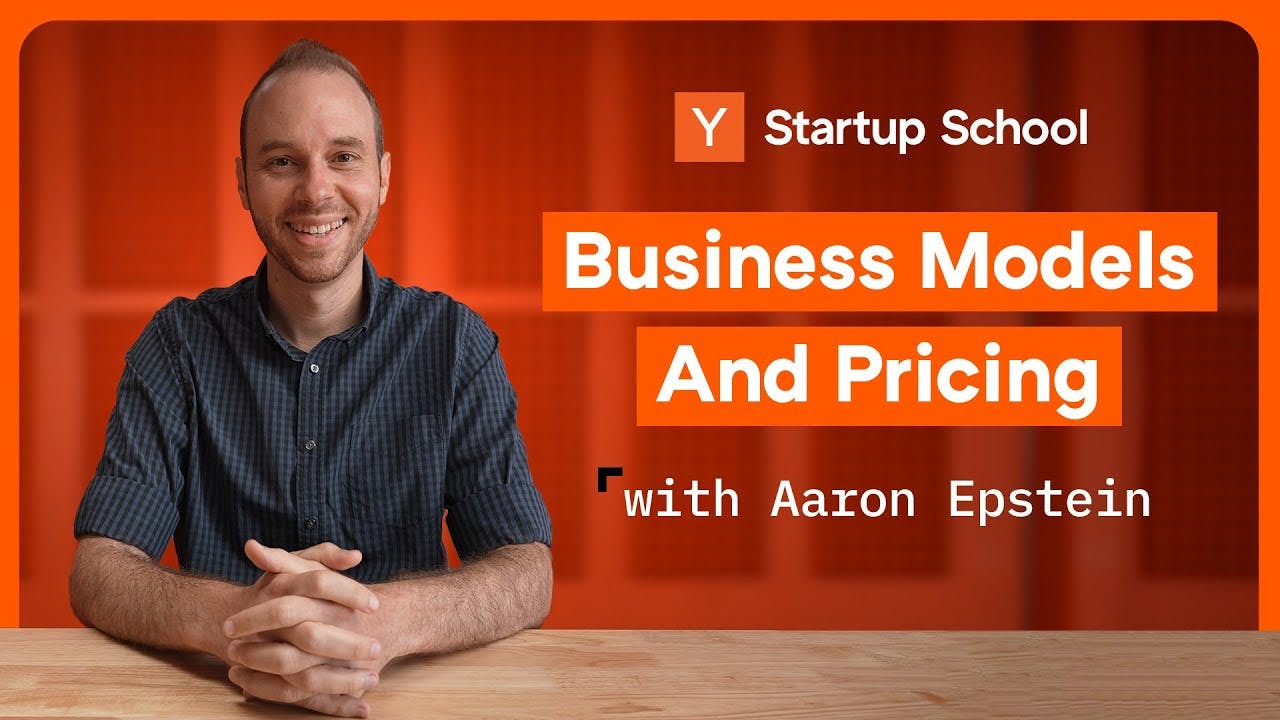Startup Business Models and Pricing | Startup School
30 Oct 2023 (2 years ago)

Introduction (0s)
- Aaron Epstein, a group partner at Y combinator discusses business models and pricing in startups.
Outline (13s)
- The focus is on three main topics: the business models of nearly every billion-dollar company, business model lessons from YC's top 100 companies, and startup pricing insights from companies that have gone through YC.
9 business models that build billion-dollar companies (42s)
- The importance of having a proven business model is stressed.
- The nine key business models that have produced most billion-dollar companies are identified: SaaS, Transactional, Marketplaces, Hard Tech, Usage-Based, Enterprise, Advertising, E-commerce, and Bio.
- An outline of the key attributes of each model is provided.
Business model lessons from the top 100 YC companies (2m28s)
- Insights drawn from the top 100 YC companies: 67% follow the SaaS, Transactional or Marketplace models.
- Advertising and e-commerce models are less represented in the top 100 list.
- Half of the overall value of the top 100 companies comes from the top ten.
- Marketplaces tend to build 'winner-take-all' companies that become massive and leave little room for competition.
- Transactional businesses outperform due to being directly in the flow of funds.
- Recurring revenue makes SaaS businesses great, as it's consistent and predictable.
- Few advertising businesses become big winners. For such a business model to win, it needs to be a top 10 site on the internet.
Overall lessons (9m42s)
- No services or consulting businesses are in the top 100 list, since they have non-recurring revenue, scale with people rather than software, and have low margins.
- Recurring revenue consistently creates winners due to its predictability and lower customer acquisition costs.
- High retention is essential for recurring revenue models.
- The biggest winners are built with moats, such as network effects, lock-in and high switching costs, technical innovation, higher margins and better unit economics.
- High-performing businesses generate recurring revenue, build defensible moats, stay close to the transaction, scale with software not people, and use proven business models. It's essential to focus on innovation in the product, while copying a proven business model.
5 pricing insights from top YC companies (16m6s)
- Pricing is a tool that can teach you who wants your product, how much they desire it, the value your product offers to users, and which channels can be utilized for customer acquisition.
- It is important to charge for your product. The fear of customers not buying or turning to competitors often discourages founders from charging. However, charging helps understand whether users see the value in your product and are consequently willing to pay for it.
- Charging can help identify which customer segments are most willing to pay. Setting higher prices can help gauge the value users see in your product.
- Starters often commit the mistake of overanalyzing pricing. It is recommended to find the right order of magnitude for pricing and to realize that pricing is not permanent.
- Founders should not base pricing solely on cost (the cost to serve customers). Instead, they should consider both the perceived value that customers see in your product and the price they are willing to pay.
- Incrementally raising prices until getting pushback from users can help find the ideal price.
- Lower prices are not a sustainable advantage; most start-ups underprice. Having price as the only differentiator is not recommended; higher prices drive higher margins and imply higher value.
- Raising prices is the easiest way to grow Revenue. If the users refuse to pay more, it either means that the product needs more value or that a bigger problem needs to be solved. In some instances, a lower price might be given in exchange for some benefits.
- Pricing is not permanent; founders can increase prices on customers over time. There are different strategies to do this.
- It is important to keep the pricing model simple to increase customer conversion rates.
Story of Segment - How to charge for your product (29m15s)
- Segment, a company that helps businesses harness their customer data, initially attempted to gain users by offering its product for free.
- However, in a bid to show revenue growth and attract investment, the company decided to introduce a charge of $10 per month ($120 per year) for their previously free service.
- This move was met with surprising reactions from customers, who expressed that they would rather pay more for the service to ensure its reliability and longevity. This indicated to the Segment team that a low price might suggest lower value to customers.
- Segment then hired a sales advisor who suggested they increase the price significantly, arguing their product was an enterprise-grade solution and that they should be charging $120,000 per year rather than just $120.
- Anxious about the potential backlash from their customers, Segment proposed the new price to their customers, who counteroffered a lower rate.
- Eventually, they settled on a price of $18,000 per year, marking a 150 times increase from their original price. This move showed the importance of not undervaluing their product and laid the foundation for continued growth in their deal sizes.
- The change in pricing strategy contributed greatly to Segment's successful growth and eventual acquisition by Twilio for over three billion dollars.